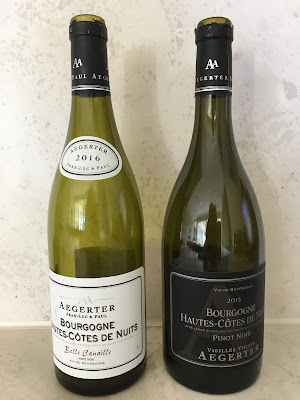The warm 2015 Burgundy vintage is hailed as a great one, but there is some concern that typical characteristics of the Pinot Noirs have been lost due to the warm weather. I decided to buy a small amount from probably the premier Burgundy area these days, Vosne-Romanée. The concern here is even greater, as wines from this terroir tend to be bigger in any case. Studying the terroir helps in this situation.
When I was in Burgundy in 2016, I tasted and was impressed with wine from the 1er cru vineyard Les Petits Monts. It sits above the famous Romanée and Richebourg vineyards. At higher altitude, it is a little cooler - an advantage in 2015.
So the moment has come to taste the two wines I have from this vineyard: the 2015 Mongeard-Mugneret Les Petits Monts and the 2015 Georges Noellat Les Petits Monts.
The two wines have a lot in common; a brilliant red colour of medium density, a great mouthfeel with flavours lingering on the palate, a silky overall package, and a very long and expanding finish.
Then some subtle differences emerge; the Mongeard-Mugneret has a slightly lighter colour. It is a bit more perfumed and elegant in a feminine way. There is slightly more acidity.
The Georges Noellat is slightly darker, slightly riper and firmer. Apart from the red and black berry flavours, olive notes and savoury underbrush flavours emerge.
These differences are quite small. The main point is that fruit flavours and tannins of both wines are exceptional and of grand cru quality. There is one conundrum, in particular with the Georges Noellat. The acidity is relatively low. Ageing the wines would increase complexity, no doubt. But there is a risk that these wines become a little dull with too much bottle age. What is wrong with drinking an outstanding wine right now?
Score for both: 97/+++















